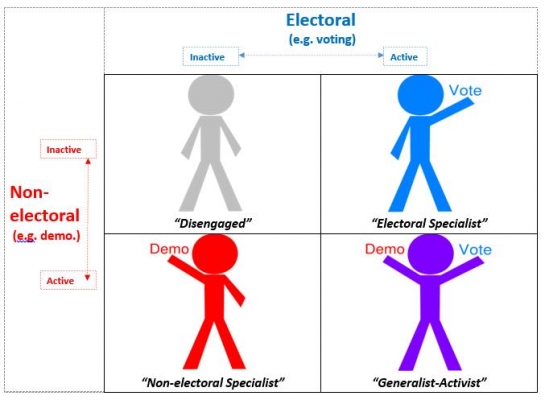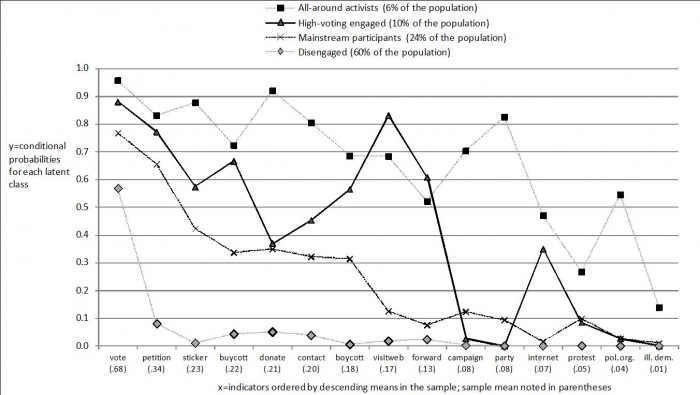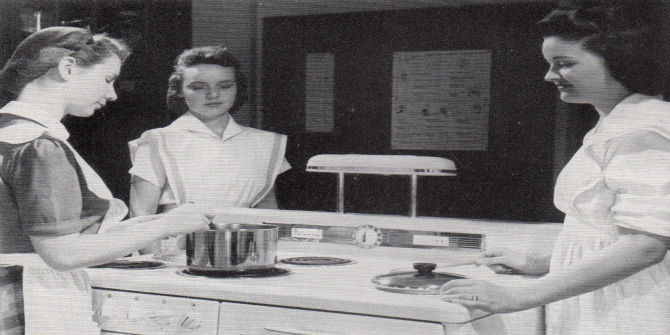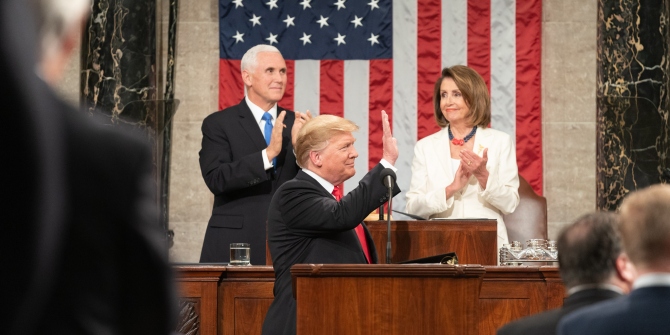 Do some people specialize only in electoral-oriented political participation such as voting, while others are active only beyond the electoral arena, participating in protests and demonstrations? In new research Jennifer Oser examines participatory inequalities by analyzing how people combine opportunities for political action in practice. She finds that most of those who are activists also vote, and that despite new opportunities for political activism, the majority of citizens are largely disengaged from politics.
Do some people specialize only in electoral-oriented political participation such as voting, while others are active only beyond the electoral arena, participating in protests and demonstrations? In new research Jennifer Oser examines participatory inequalities by analyzing how people combine opportunities for political action in practice. She finds that most of those who are activists also vote, and that despite new opportunities for political activism, the majority of citizens are largely disengaged from politics.
In a crowd-pleasing line from Barack Obama’s speech at the Democratic National Convention in 2016, the then President confronted the jeering crowd at the mention of Donald Trump’s name with a scolding head-shake: “Don’t boo. Vote!” And the crowd goes wild.
“Ideal Types” of Political Participators
In recent research, I use a new approach for studying whether citizens actually “boo” AND vote – and are active in additional types of increasingly prevalent political activity beyond the electoral arena as well.
The stick figures in Figure 1 help explain this approach and why it’s important in the current era of newly emerging ways to participate in politics, such as online activism and political consumerism. Two broad categories of political activity are often identified in political research, as shown in the figure: “electoral” activities, such as voting and campaign activity; and “non-electoral” activities, like demonstrating, online activism, and political consumerism.
Figure 1- Four “Ideal Types” of Political Participators: Conceptual Model

Based on individual combinations of electoral and non-electoral participation
Notes: Author’s conceptual typology of participator specialist types. For additional information on studies categorizing these different types of political activities see research article discussion of “ideal types” of participators (pp. 239-240).
It is common to assume that some citizens can be thought of as “Electoral Specialists” (the blue stick figure in the top right) who vote and participate in additional electoral campaign-oriented activities, but are inactive beyond the electoral arena. Another common assumption is that there is a “Non-electoral Specialist” participator type (the red figure) that is active in a variety of elite-challenging activity such as protest and online activism, but is uninterested in electoral-related activities.
The “electoral specialist” and “non-electoral specialists” are often referenced in research on expanding repertoires of political participation, but Figure 1 shows that at least two other types of participants are possible. A witty commentator to the image file of Obama’s punch line wrote simply “I can do two things” – and indeed, the “Generalist-Activist” type (purple) embodies this. The final type is clearly the “Disengaged”, meaning those who neither “boo” nor vote – and are also inactive in other ways, despite the increasing opportunities for political activity.

Photo by Alice Donovan Rouse on Unsplash
Types of Political Participators Identified in the United States
How do these “ideal types” of participators compare to reality? To test what types of participators can be identified in practice, it is important to analyze data that includes a wide variety of political acts such as the US “Citizenship, Involvement and Democracy” (CID) survey from 2005. Figure 2 shows the findings of my analysis that uses an actor-oriented analytical technique (latent class analysis) to identify how individuals combine a variety of political acts in their individual-level repertoire of political participation. This approach is useful for understanding how individuals are combining (or not combining) newly emerging types of citizen participation – such as online activism and boycotting – with more traditional political activities such as voting.
Figure 2 – Four Types of Political Participators in the US in 2005

Source: Latent class analysis of US CID 2005, n=966.
For related research that uses latent class analysis to study types of political participators see studies on online / offline participators (Oser, Hooghe & Marien 2013) policy preferences of participator types (Oser, Leighley & Winneg 2014); youth participation in Britain (Keating & Melis 2017); and participation in Argentina (Alvarez, Levin & Nuñez, forthcoming).
As the variety of political acts has increased beyond the realm of electoral-oriented actions, some have proposed that broadening our research lenses to include a diverse range of political behavior may reveal a renewal of political engagement. Particularly among contemporary youth, it has been proposed that young people are politically active, but simply focus their energies beyond the electoral arena.
Figure 2 shows how we can shift from the common approach of analyzing political acts as separate items on a questionnaire to political actors who combine these items in specific ways. The results show no evidence of an electoral-oriented type of participator. While the analysis identified an engaged type of participant that emphasized non-institutionalized participation, this group has a very high probability of voting – the “high-voting engaged” group (10 percent of the population). Importantly, the findings show that a majority (60 percent) of citizens are best characterized as disengaged, while a small group of all-around activists (6 percent) engage in all possible opportunities for political action.
These findings show that new opportunities for political activism do not necessarily recruit disengaged citizens into political activism. Instead, we must keep in mind that a small group of activists engage in all possible political acts, while a large group of citizens are disengaged. This means that an important approach for understanding participatory inequalities in an era of expanding opportunities for political action is to analyze how actors combine separate political acts – and not only the separate political acts themselves.
Returning to Obama’s rally cry of “Don’t boo. Vote!” these findings show that the voting levels in this US sample were not depressed by the presence of an engaged group of young participants who uniquely emphasized political action beyond the voting booth. The evidence indicates instead that among those who vote are also individuals who have expanded their personal repertoire of political participation to include new political opportunities as they arise.
In an era of increased inequality of all kinds, it would seem that more attention must be paid to the low-voting disengaged group – a full 60 percent of the US population in 2005 – whose members did not take advantage of the many increasingly prevalent acts of political engagement. For this purpose, studies such as Hahrie Han’s (2016) investigation of the organizational roots of political activism in the US are needed in different contexts in order to investigate how new active citizens can be recruited and developed.
- This article is based on the paper: Assessing how participators combine acts in their “political tool kits” in Social Indicators Research
Please read our comments policy before commenting.
Note: This article gives the views of the author, and not the position of USAPP – American Politics and Policy, nor of the London School of Economics.
Shortened URL for this post: http://bit.ly/2lZAlZc
_________________________________
About the author
 Jennifer Oser – Ben-Gurion University
Jennifer Oser – Ben-Gurion University
Jennifer Oser is an assistant professor of Politics and Government at Ben-Gurion University in Israel. Her research focuses on the relationship between public opinion, political participation, and policy outcomes.






